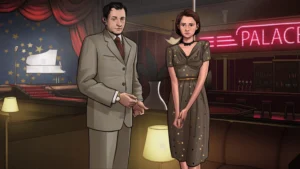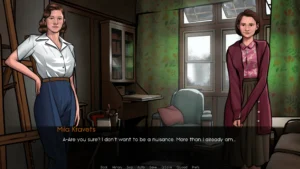
The Silver Lining
Play The Silver Lining
The Silver Lining review
Exploring the immersive experience and features of The Silver Lining game
The Silver Lining game offers a distinctive interactive experience that blends narrative depth with engaging gameplay. Known for its unique storytelling and character development, this game has captured the attention of a dedicated audience. In this article, we explore what makes The Silver Lining a compelling choice for players seeking an immersive and personal gaming journey.
Understanding The Silver Lining: Gameplay and Storyline
Have you ever played a game that made you pause, put the controller down, and just think? 🤔 Not about a tough boss fight or a tricky puzzle, but about the weight of a decision you just made? That’s the unique magic of The Silver Lining game. It’s less about winning and more about feeling, pulling you into a world where your moral compass is your most important tool. This chapter is your guide to understanding exactly how it weaves its spell, from its intricate gameplay mechanics to its heart-wrenching narrative.
What is The Silver Lining game about?
At its core, The Silver Lining is an emotional journey. You step into the worn-out shoes of Leo, a former paramedic navigating a rain-slicked, neon-drenched city that feels both futuristic and decaying. 🏙️ The core narrative themes here are resilience, guilt, and the search for hope in a world that seems determined to snuff it out. Leo is haunted by a past tragedy he couldn’t prevent, and the entire game is his path toward finding his own silver lining.
The story begins with Leo taking a job as a crisis responder, but not for emergencies you’d expect. He answers calls from people on the brink—of despair, of giving up, of making a terrible choice. Your job isn’t to fight monsters with a gun; it’s to fight despair with words and empathy. This setup is the brilliant foundation for an interactive story that is profoundly personal and different for every player. You’re not just watching Leo’s story; you’re actively writing it with every choice you make.
Core gameplay mechanics and player interaction
So, how do you actually play? Forget complex combat systems. The primary gameplay mechanics in The Silver Lining are built on conversation and exploration. The city is your hub, and you navigate it between calls, uncovering bits of lore and glimpses into the lives of its citizens. 🚶♂️
When a call comes in, the real interaction begins. You’re presented with dialogue trees, but these aren’t your typical “Good/Neutral/Evil” responses. The options are nuanced, reflecting different approaches like compassion, logic, deflection, or even shared vulnerability. The game’s brilliant system analyzes your choices, shaping the caller’s emotional state and, ultimately, the outcome of their story. This is where player choices carry immense weight. There are no “right” answers, only authentic human reactions.
The game also features a “Focus” mechanic. By holding a button, Leo can calm his own breathing and focus on the caller’s environment through the audio. You might hear a distant siren, the faint sound of music, or the tremble in their voice—details that provide crucial context for your next move. This mechanic is genius because it literally makes you pause and listen, reinforcing the game’s thoughtful pace.
To break it down, here’s a comparison of how these systems work together:
| Gameplay Feature | How You Interact | Impact on the Story |
|---|---|---|
| Dialogue Choices | Selecting from nuanced conversational responses during calls. | Directly influences the caller’s immediate outcome and long-term fate; shapes Leo’s personality. |
| City Exploration | Walking through districts, interacting with objects, and finding audio logs. | Unlocks deeper backstory for the city and Leo; provides context for future calls. |
| Focus Mode | Holding a button to listen intently to the audio feed and your surroundings. | Reveals hidden clues and emotional subtext, informing better dialogue choices. |
This blend of mechanics ensures you’re never a passive observer. You are an active participant in every conversation, and that’s what creates such a powerful immersive experience.
Narrative structure and character development
This is where The Silver Lining truly shines. The narrative isn’t a straight line; it’s a web of interconnected stories that you unravel one call at a time. 🌐 Each person you help (or fail to help) leaves a mark on the world and on Leo. The character development is dual-layered: you’re developing the callers, helping them find their path, and you’re simultaneously developing Leo, helping him heal from his own trauma.
I remember one call vividly. It was from a young artist who had lost all inspiration and saw no point in continuing. My first instinct was to offer pragmatic, logical advice. It didn’t work. She shut down. I failed that call. I had to sit back and watch the “Call Ended” notification flash on the screen, and I felt a genuine pang of guilt. 😔 I reloaded my save (something I rarely do, but I was so invested) and tried a different approach. This time, I shared a personal insight from Leo’s past about finding beauty in small, broken things. The conversation completely turned around. She started talking about the light filtering through her dirty window and how it looked like a painting. That shift, that tiny spark of hope I helped ignite, was more rewarding than any high score.
This is the power of its interactive story. Your player choices don’t just change a ending slide; they change how you feel about yourself as a player. Did you be blunt to efficiently solve the problem, or did you take the time to truly connect? The game made me confront my own instincts. The narrative themes of consequence and empathy are baked into every single interaction.
The immersive experience is amplified by the game’s stunning audio design. The city sounds, the rain, the raw emotion in the voice acting—it all pulls you deeper into Leo’s world. You don’t just guide him; you are him, making these impossible calls and hoping you said the right thing. By the end of your journey, both the city and Leo are fundamentally different because of the path you chose to walk. And that, ultimately, is the unforgettable appeal of The Silver Lining game. ✨
The Silver Lining game stands out for its rich storytelling and engaging gameplay that invites players to immerse themselves in a unique interactive world. Its emphasis on player choice and character depth creates a memorable experience that resonates long after playing. Whether you are new to this game or revisiting it, The Silver Lining offers a rewarding journey worth exploring. Dive in and discover the layers that make this game a standout in its category.









